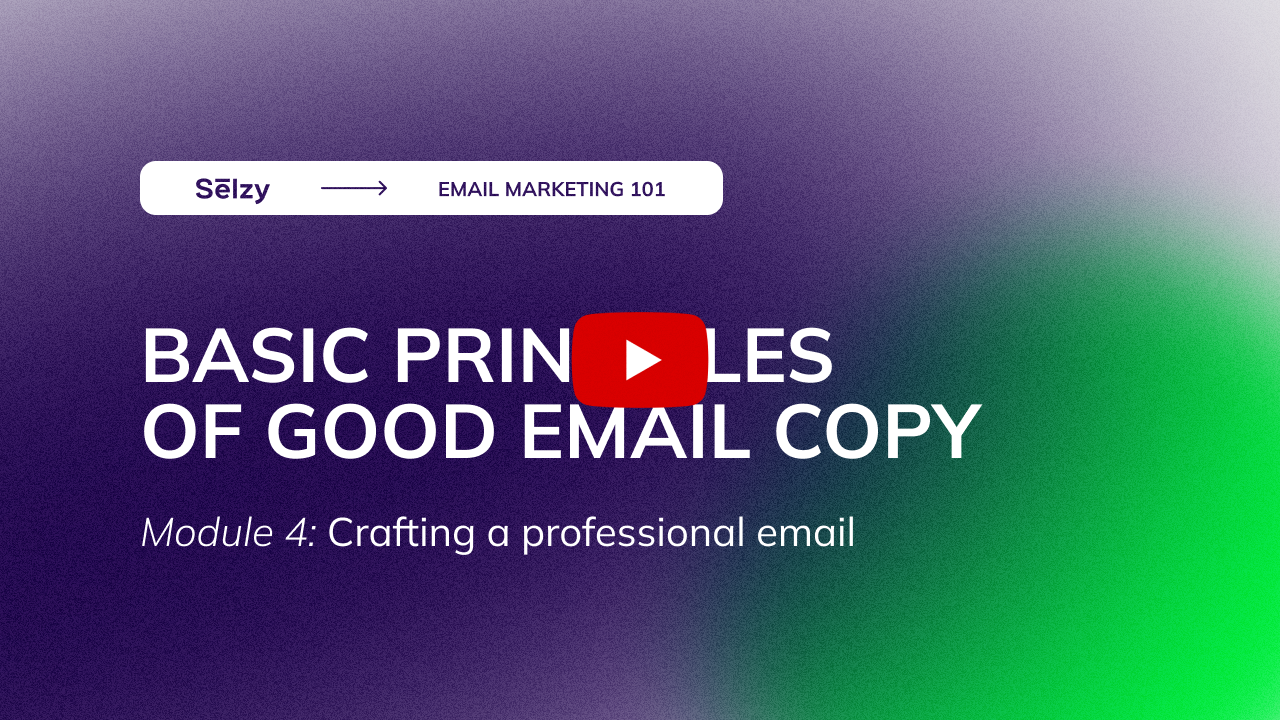Writing 101: Basic Principles of Good Email Copy
This is a transcript of lesson 10 of Email Marketing 101 Course by Selzy.

Hello, and welcome to Module 4. In this part of the course, we’ll create your first marketing email step by step.
In the beginning was the Word, so we’re starting this module with a lesson about email copy. Whether you’re writing a welcome sequence, a monthly newsletter or a re-engagement email to win your customers’ hearts back — all types of email obey the same rules when it comes to writing. That’s why we’re dedicating the entire lesson to all things copy.
Here, you’ll learn all you need to write fire emails that will appeal to your audience — from the basic principles of good writing to finding your tone of voice. Let’s go!
How to create professional email
The first rule of the Commercial Writing Club is:

This visual is only available in a video lesson
What does it mean?
Think like your reader
How do they see the world, and how much do they know about it? Ask yourself these questions and write a copy using that information. The answers will affect which words you use to explain certain concepts, and which features of your product you will highlight:

This visual is only available in a video lesson
Can you still include technical information? Yes but explain how it benefits your customers. Let’s rewrite our previous example:

This visual is only available in a video lesson
Be useful
A good content copy resolves readers’ pain points — gives them useful information, empathizes with them, entertains them, or gives a valuable offer. Here’s an example:

This visual is only available in a video lesson
The example on the left says nothing about how the company can help and what it does. The example on the right explains what the company can do for the reader. You don’t have to be this verbose — but avoid vague claims and bragging about your achievements.
Be clear
Your customers don’t want to crawl through run-on sentences — they want to get the gist in seconds. Avoid passive voice, verbose sentences, adverbs, and complex vocabulary. Write as if you were writing for a kid with poor attention span.

This visual is only available in a video lesson
The example on the right is more readable — save long sentences for your next novel.
Be brief
According to Campaign Monitor, the ideal email copy length is between 50 and 125 words. However, this rule is more applicable to promotional emails. Newsletters can be a bit longer. Turning all your emails into short novels is still not a great idea though.
And these are the basic rules of a good email copy — respect your reader, think of how your copy can benefit them, and don’t waste too much of their time. Does it mean all brands write in the same style? No!
Once you master the principles of good commercial writing, it’s time to move to the next step…
How to find your unique tone of voice
Let’s start with an example. Compare this email:

This visual is only available in a video lesson
To this email:

This visual is only available in a video lesson
Why are these copies so different? It’s the tone of voice — the consistent mood you convey in every message on behalf of the brand. Think of it as different arrangements of the same song — you can play the same melody like a heavy metal banger or a soft RnB piece. The melody is the baseline message you want to convey and the “music style” is your tone of voice:
The words you choose: compare “convenient” to “hassle-free”.
The way you communicate with your audience: compare Cards Against Humanity’s signature “Dear horrible friends” with a more neutral “Dear subscribers”.
The way you talk about your brand: compare “Our team” to “Our alliance” or “Our organization”.
Here’s how to find your brand’s tone of voice
Think of your values. It would be weird if your brand was feminist but threw “Your mom” jokes here and there. That’s why considering your values is important — you can’t express your brand personality if you know nothing about it.
Think of your target audience. Which tone will appeal to them? Do you want to talk to them like friends or business partners?
Describe your brand in three words. For example, Cards Against Humanity’s description would sound like “Edgy. Sarcastic. Self-aware”.
Choose the vocabulary. The tone of voice is not what you say but how you say it. It’s time to dig into thesaurus. Here are some examples:
Think of this: which column is more appealing to a younger audience and which one is better for an older audience?

This visual is only available in a video lesson
Language is more nuanced than slang and formal vocabulary — our examples are just a starting point. However, not all words are equally… handy.
Let’s talk about stop words
Stop words include conjunctions, prepositions, adverbs, and articles — these are the words that don’t contain information outside the context. Of course you can’t write a coherent sentence without them — but overdoing it will make your copy harder to read.
Think of your copy as a bag of chips — the more stop words you use, the more “air” it contains. Compare these 2:

This visual is only available in a video lesson
Want to have less “air” and more “chips” in your copy? Watch out for:
Prepositional phrases — remove them or replace them with adjectives, genitive case, or other shorter word combinations.
Predicates with complex structures — replace them with simpler alternatives.
Passive voice — it contains more “empty” words.
Redundant phrases — don’t repeat the same idea twice, as in “The wooden table is made of wood”.
Having a hard time self-editing? We get it! Self-editing is like cooking: it works sometimes but it’s better when someone else is doing it for you. But if you have no other options, machines don’t miss a thing. Now, let’s talk about some solid Editors Ex Machina that will improve your writing.
How to check yourself
Let’s talk about three apps that will help you improve email copies.
Grammarly
This AI-powered proofreader detects grammar and spelling mistakes like a pro for free — and its browser extension is compatible with most websites and apps, including ESPs.
The paid version has more on the table — it suggests clarity and vocabulary improvements. And a business plan suggests tone of voice improvements based on your style guide.

This visual is only available in a video lesson
You can use Grammarly for self-editing if:
- English is your second or third language
- Or you make a lot of typos
Hemingway
Hemingway Editor is a “spell checker” for style – and it is 100% free!. It’s a website where you can paste your copy and see your poor stylistic choices highlighted in different colors. Hemingway checks texts for:
- Sloppy sentences that are “hard” or “very hard” to read
- Adverbs — the app suggests using more powerful verbs instead
- Passive voice — this one is especially great for commercial writers
- Overly complex words — the app suggests simpler alternatives

This visual is only available in a video lesson
Use Hemingway for self-editing if:
- You tend to be excessively verbose
- You’re a newbie in commercial writing
- You don’t have enough time to fish out stop words manually
Copywritely
From spelling to style — Copywritely does it all. Style-wise, it checks:
- Gunning fog index — the estimation of how easy it is to grasp what you’ve just written
- Flesch reading ease score — the estimation of the text’s readability using relations between the average sentence length and the average word length
Copywritely also checks your text for plagiarism and SEO. The best part is, you can check everything in one place.

This visual is only available in a video lesson
Use Copywritely for self-editing if:
- You also write for a blog
- Your emails are longer than an average “Here’s your discount”
- You’re patient enough to look through false spelling errors
Using apps is great but machines make mistakes too. For example, automated spell checking tools are based on the pre-uploaded list of words that may not include slang or terms from your industry. Keep that in mind!
You should also keep in mind that a perfect copy is not enough for a good marketing email.
What else should you think about?
If you focus on the copy alone, you’ll get a plain text email. They are great for transactional sequences. But think of a Black Friday campaign. Will you click on the blue “Buy now” link hidden in the wall of text with no illustrations?
Content goes beyond writing — let’s talk about two important ingredients of the perfect marketing email.
Ingredient #1: Readability
When people talk about email design, they pay more attention to the fun and creative part. But design goes beyond aesthetics. Remember what we said about readability? It’s not just how you write — it’s also:
Typography — for example, sans-serif fonts are easier to read than serif fonts
Formatting — you can use bold or cursive to highlight the important parts
Color schemes — your colorblind subscribers won’t thank you for green letters on a red background
Paragraph spacing — break your copy into smaller parts with blank space between paragraphs, pictures, and blocks with CTA buttons
Here are more reasons why design is important:
Accessibility: if everyone can read your copy regardless of their special needs, it shows that you care about all your subscribers
Responsiveness: if your email looks like a mess on mobile devices, you cut off a large part of your audience
Persuasive power: good pictures and GIFs paired with a decent copy are more convincing than plain text
And, since we mentioned persuasion, there is a separate email element responsible for it.
Ingredient #2: Good Call-to-action
A call to action is a button or a link that redirects the reader to a website or an app page. It usually looks like this:

This visual is only available in a video lesson
Let’s break it down:
The CTA copy is concise, clear, and simple — “Shop now” or “Buy now” are the most common CTAs in sales emails.
The button is large enough to click on sensor screens, and it’s visible on the background thanks to the contrasting color.
What would this email look like without a CTA? Like this:

This visual is only available in a video lesson
It’s not convenient for you and your customers. Replace a verbose instruction with one button — and you’ll get more purchases.
However, CTAs are more complex than they seem. For example, simple “Shop now” copies don’t always work. But that’s the whole other story. To learn more, proceed to the next lesson.
This is a transcript of lesson 10 of Email Marketing 101 Course by Selzy.